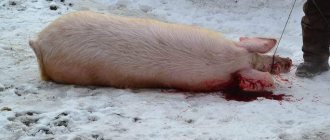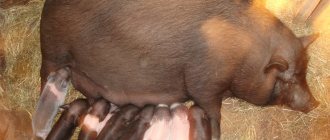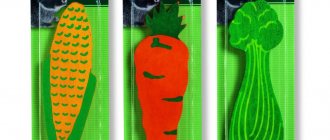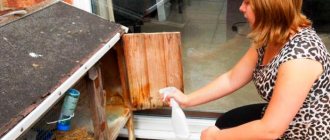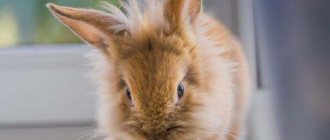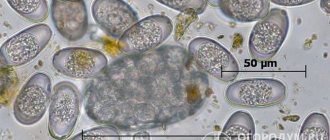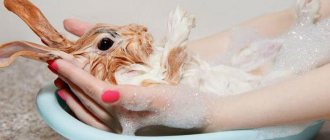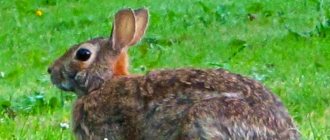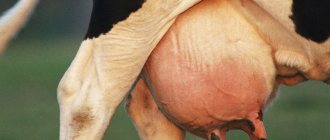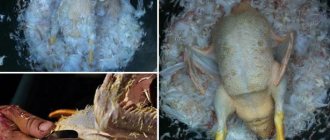When the bunnies are ready
It is believed that rabbits are ready for mating at 4 months, and a male can already be placed. Previously, it was not advisable to do this if the breeder wants to get healthy and strong offspring that are resistant to disease. This is not considered an unconditional rule - if you have rabbits raised primarily for meat, you can start mating later, at 5 or 6 months.
However, getting involved in keeping rabbits is also not very useful. Due to the lack of reproduction, they can gain unnecessary, excessive weight; subsequently, the female rabbits produce few rabbits.
White rabbits mating
Important information! The male must be 2 months older than the female, as they become sexually mature later.
A female that is considered healthy can give birth to rabbits up to 7 times in one year, regardless of the time of year. In autumn and winter they give birth somewhat less frequently due to the weather. But in winter the offspring are much stronger. If rabbits are raised for their fur, it is best to breed them in the winter. Rabbits don't molt.
Increasing lactation with the help of medications
Another way to increase lactation is medications. For example, the hormone oxytocin is used, which causes an increase in lactation through uterine contractions. After using it, milk appears within 24 hours.
The use of oxytocin does not guarantee the occurrence of lactation. If all else fails, you need to place the baby rabbits with nursing rabbits or feed them yourself using a pipette. It is very important to ensure that newborn rabbits are fed only on the first day.
When to happen after childbirth
When can you give birth to a female rabbit after giving birth? If we approach this issue based only on the physiology of the animal, then the female’s readiness for mating after she gives birth can be determined almost immediately. It is important not to forget that just at this time, in the first days after birth, she spends a huge part of her body’s available resources on milk for the rabbits.
What to feed a female rabbit after giving birth to produce milk
Important! You should not get carried away by too frequent matings of animals, this is fraught with weakening of the rabbit’s body, and her maternal instincts may deteriorate significantly.
The number of offspring left must strictly correspond to the number of mother's nipples, otherwise there will be nowhere for one bunny to go when feeding. It’s even better if there is one less baby rabbit, otherwise it may die. Several methods can be identified in modern rabbit breeding for covering female rabbits after birth.
Rabbit with offspring
The first technology is called industrial. The female rabbit carries offspring for about a month or a couple of days more. She is capable of bringing up to 10 rabbits, which grow very quickly.
You can make the female bring up to 10 times a year, but about seven is considered preferable and gentle. Industrial farms adhere to this parameter; they use a female for only 1 year; less often, rabbits are left for a breeding period for 2 years.
The female at industrial rabbit breeding facilities can become covered quite intensively, so the animals there are fed very well. With this feeding they reach sexual readiness faster. The rabbit at such enterprises can be allowed to approach the female approximately 20 days after the birth of the cubs.
Rabbit after giving birth
After a female gives birth seven times in a year, she is usually culled; this can happen a little earlier. This may be due to illness or poor quality litter.
The second method is to compact the litters. The essence of this method is that you can cover the rabbit who has given birth almost immediately, on the second or third day. With such a short interval, the embryos are not in danger. Baby rabbits that are born are separated from their mother within a month so that she can safely bear the next offspring.
This technology is applicable in large enterprises and is possible in an ordinary household. In this case, extreme caution should be taken and the animals should be fed correctly. The correct conditions of detention are also important.
Additional Information. There is a method of semi-compacted births. In this case, the female can be covered after 2 weeks, and the offspring are separated from the mother after 35 days.
With this technology, after the cubs are separated, the rabbit’s place must be thoroughly cleaned and possible infected areas must be disinfected. The female must obtain material from which she can make a nest for herself.
Many females cannot withstand such intensive reproduction even up to the age of one year; they become very weakened, and their health seriously deteriorates. Experienced rabbit breeders advise doing this only in spring and summer, because rabbits can be fed with vitamin-rich green food.
Pregnant female
There is another technology called standard. As a result, it is believed that the best offspring are obtained. The rabbits are healthy and the survival rate is high. Using this method, the female can be mated no earlier than a month after the previous litter. Baby rabbits spend about 1.5 months with the female rabbit, so their immunity is strengthened. In addition, they quickly gain weight. With this method, a female rabbit can give birth to about 40 cubs per year, which are strong and healthy.
Rabbits at work
The technology is successfully used in farms with a small number of rabbits. In such conditions, the female is used fully for up to 2.5 years. The rabbit breeder himself decides when to crossbreed animals and what technology to use for personal farming. It all depends on your goals. Depending on this, it is determined when the female rabbit can be mated after giving birth.
Mass matings and litters
Large farms use not only cages for keeping rabbits, but also pits, which are convenient for free mating. Pit breeding is used to increase the number of livestock by large farms. Cage breeding allows you to control everything and is used by small and medium-sized breeders to produce breeding young animals.
Mass matings should be carried out at approximately the same time, for 5-6 days, selecting for them the most suitable individuals of breeding age. This will allow you to get offspring at the same time and regulate the number of newborns in each nest.
Thus, some multiparous females are capable of producing up to 12-16 rabbits, which they find difficult to feed evenly. Others give birth to 5-6 heads, but are quite capable of raising not only their own, but also other people’s babies.
Redistribution increases the chances of the offspring to fully develop all individuals in it.
Such methods are suitable for breeding rabbits not only for production, but also for breeding. For these purposes, producers are kept for no longer than 3 years, and only in exceptional cases up to 6 years. At this age, their reproductive abilities are still preserved, and the male is able to cover about 8 rabbits per day.
Miscarriage in a female rabbit
Video: When to open garlic after winter
When the female rabbit has good health and immunity, and her pregnancy follows all the rules, then with a high degree of confidence we can expect a full increase in the number of animals. An unexpected miscarriage in a rabbit indicates that she is not entirely healthy.
Newborn rabbit
This happens for a variety of reasons, but there are a number of main and most common ones:
- The rabbits' nutrition does not meet the required standards. The food used is not of very good quality, or the feeding ration is incorrectly formulated;
- Situations in which animals were frightened or moved to another location were generally subject to stress;
- The rabbit fell ill, and the infection especially affects the offspring.
Newborn rabbits
In such situations, embryos are capable of freezing. This usually happens from 10 to 20 days, after which they can simply resolve. The negativity of situations is directly related to the possibility of miscarriage.
A female rabbit that is pregnant requires much more nutrients in her diet, because the rabbits inside her must also receive the necessary vitamins. When there is a shortage of them, the mother’s body is weakened, the embryos do not receive the necessary nutrition and may freeze.
Newborn rabbits
Here are common nutritional mistakes that sometimes lead to disastrous consequences:
- Animals suffer due to insufficient food, that is, they are underfed;
- Vegetables that are known to be rotten or unwashed can be used. The main feed is of unacceptable quality;
- The food is too monotonous, so the rabbit does not receive nutrients and minerals in the quantities necessary for gestation;
- The water is of poor quality, cloudy and stale.
Feeding rabbits
Nutrition is what it should be for good bearing of offspring:
- Feeding is more intensive, there should be a little food in reserve. The animal should not experience hunger;
- Dietary variety is a must. Mixed feed, cereals, vegetables, hay, grass, beans must be present;
- It is very important to properly balance your diet. Vitamins of groups A, D, E are needed. Protein and calcium are also used;
- Vegetables are inspected for rot, feed must be of high quality;
- They also monitor the cleanliness and freshness of the water.
Feeding rabbits
Rabbits are rather shy animals. Moreover, the stress that they experience in such situations is so strong that their health then seriously deteriorates, sometimes they can even die. Pregnant females are in the most vulnerable risk group. After the fear experienced, there may well be stillborn cubs.
Here are some situations that can cause stress:
- General noise coming from outside;
- Careless handling of them by the rabbit breeder. This may include loud screaming and rudeness to animals;
- Unclean cage, lack of adequate space and adequate ventilation;
- Relocation to another place, transportation;
- The presence of a large number of other species of animals or people nearby.
Transporting rabbits
To avoid such situations and, as a consequence, the possibility of a miscarriage in a rabbit, it is necessary to ensure the following conditions:
- Noise sources must be located at a remote distance;
- Rabbits must be kept clean;
- Other people and animals should not be in close proximity to the animals;
- If possible, do not move the cage, move or relocate the rabbit during this period;
- Ensure very careful handling of the expectant mother, do not shout or make noise.
Caring for rabbits
Preparation
The gestational period, depending on the type of female, can last 26-35 days. Females of large breeds carry their rabbits for a longer period. The most important condition for a successful birth and obtaining a full-fledged offspring is high-quality nutrition for the expectant mother, on a par with the rabbit.
Females need to be fed more succulent food and high-calorie crops (grain, beans). If hay is served, it must be prepared according to the rules. The body of the pregnant uterus rapidly releases useful elements to the embryos; their deficiency should be replenished. The expectant mother should receive vitamins and minerals
It is especially important to replenish calcium
Vitamins for rabbits
You can give biological supplements and crushed calcium gluconate tablets together with wet mash, pour into drinks. Tablets and a piece of ordinary chalk can simply be placed in a rabbit cage: it will chew as much as required. Rabbits need to create a quiet, cozy environment. They should not be taken out of their cage unless necessary.
If you need to move the female, proceed as follows:
- lure her in with food so she doesn’t worry;
- grab by the withers;
- support from below.
If the female is already raising a litter, she should be placed in a cage for young animals about 5 days before the time comes to give birth. It is imperative to separate mother and children. You should not place the uterus in another cage; you must wash the one in which you lived before. Pre-disinfect, lay down fresh, non-hard straw and return it back “home”.
How many days does it take for a female rabbit to start building a nest - the female builds a warm corner for her rabbits within 24 hours from crumpled straw and her own fluff
It is important not to distract her or disturb her. You can’t pick it up or take it outside
It is especially bad if the rabbit is affected by foreign odors:
- cosmetical tools;
- tobacco;
- alcohol, etc.
Important! During childbirth, all the senses of the uterus are heightened to the limit. The birth will be more successful if, after the baby rabbits are transplanted into the cage, you make and place a queen cell (birthing chamber)
This can be a box made of plywood 40x50 cm, 35-40 cm high. You need to make an entrance measuring 15x15 cm. The birth box should be installed 15 cm from the floor surface of the cage.
The mother liquor may be different. For example, hanging ones are comfortable because they are easier to clean. There is no general opinion among breeders about the need for birthing. Some generally consider it superfluous, or build an ordinary partition. Others advise using the birthing device exclusively in winter so that the baby rabbits that are born do not die. Still others believe that a birth is needed regardless of the season.
The queen cell will protect the rabbits from frost in the winter. It simulates natural conditions, because the mother must give birth to offspring and raise them in a fairly narrow, dark hole. The female rabbit builds a nest directly in the queen cell. The lid on top is made removable to perform the required manipulations. When it is warm, it is removed.
Before the birth, you need to place a second drinking bowl in the birthing area; this is very important. Lambing rabbits at home for beginners will not be a problem if you follow the advice of the pros
The owner must prepare the nest together with the rabbit.
Preparing the nest
Why are baby rabbits born dead?
The cause of baby rabbits being born dead may be an infectious disease that can infect other rabbits. The fact is that females in a state of pregnancy become more vulnerable to the development of such diseases than the rest of the animal population. This may be myxomatosis, pasteurellosis or lesteriosis. The latter attacks the female’s genitourinary organs, as well as her mammary glands. If the female is sick, then the litter may be a little earlier, about a week. Infection of rabbits from dead animals may also occur.
Newborn rabbits
What can you plant after onions?
In this case, small rabbits may be born dead immediately or die within a few hours. Infection of a female rabbit often occurs quickly, and she may die during childbirth or immediately after its completion. To this day, there is no effective treatment for these diseases.
Important information! If the rabbit was sick with infectious diseases, especially listeriosis, or this was the cause of her death, rabbit meat should under no circumstances be eaten, as it is very dangerous for people as well. A person can also become infected.
It can also happen when, in addition to the listed factors and diseases, the birth of babies is affected by the temperature regime in the place where the rabbits are kept. The temperature should be neither too low nor too high. When it is too hot, it is bad for the giving birth rabbit, and in extreme cold, newborn babies can immediately freeze and die.
Rabbit with offspring
Unsuccessful births
Unsuccessful births include the following:
- termination of pregnancy (abortion);
- premature appearance of litter;
- natural death of the offspring;
- mother eating rabbits.
In rabbits, the uterus consists of 2 sections that are not connected to each other. Therefore, if a rabbit breeder wants to bring a male and a female together again a week after the previous mating, he must prevent fertilization from happening again. If 5 - 7 days after the first mating the female does not allow her partner to approach her, she is immediately taken away. It’s bad when repeated mating occurs, causing premature birth. This also happens: first a dead rabbit (or two) is born, and then, in due time, the rest of the litter appears, developing normally.
If the litter is stillborn or dies after a few days, the birth is considered unsuccessful. And you can’t rush into mating. First, the cause of the incident is determined and endometritis is prevented. For this purpose antibiotic treatment is used.
An unsuccessful birth occurs if the animal suffers from listeriosis. The result is that the pregnancy is interrupted by spontaneous miscarriage or resorption of the embryos. After an abortion, purulent discharge flows from the genitals. Such a rabbit is slaughtered because the disease is contagious and there is no effective treatment. As a rule, whatever the reason for the abortion, after it the females are not allowed to mate again.
Listerosis can develop in a pregnant rabbit
Prevention
To ensure that all of the above problems do not affect rabbit farming at all or happen as rarely as possible, it is necessary to carry out constant prevention. Then the females’ pregnancy will proceed without complications, and the baby rabbits will be born healthy and strong. In this case, it will be necessary to make some efforts to prevent the situations described above.
Prevention of rabbits
Here are the preventive measures you need to take:
- Feeding a rabbit must be approached with the utmost seriousness. Feed should be varied and of high quality. There should be plenty of them;
- It is better to reduce stressful situations affecting the animal to a safe minimum. The room for him is spacious and separated from the rest of the rabbits. If possible, the area should be as quiet as possible. It is preferable to handle such an animal carefully and carefully, without sudden movements or loud voices;
Feeding a pregnant female - The location of the female must be kept clean, disinfected, and have good ventilation;
- Give the female water clean and fresh. The water container is washed before each filling with liquid;
- It would be better to carry out mating using standard technology, this way you can ensure the health of the rabbit for a longer period;
- Vaccinations of animals should be carried out strictly according to the recommended periods so that other animals cannot become infected.
Pregnant female
If a miscarriage occurs once, you can use the services of laboratories where biomaterial is sent to determine the true cause, so that this does not happen again in the future.
When to happen again
After giving birth, when can you cover a female rabbit? In order to again fertilize a female who previously gave birth to dead rabbits, it is necessary to understand the reasons for what happened and take measures to eliminate undesirable factors, if possible.
Rabbits - female and male
The mother rabbit gave birth to dead rabbits, when can she now be born:
- If it was a stressful situation for the animal, it is necessary to eliminate the source;
- If improper feeding is noticed, completely or partially change the diet, improve it so that the rabbit can regain her strength for subsequent births;
- After an illness, a period of rehabilitation is required, which ends only after the animal has fully recovered.
Rabbits
When miscarriages occur more than once in one rabbit, the rabbit breeder should think about replacing the animal with another that can give birth to healthy babies.
Important! Rabbit breeders with sufficient experience are of the opinion that no matter what the birth, it is better to give the female rabbit a break for at least a month. But the owner himself decides how long after giving birth the rabbit can be covered.
Rabbits, if all maintenance standards are observed, can produce healthy offspring. If a miscarriage occurs, the rabbit breeder needs, first of all, to establish the reason why this happened and eliminate it. It is important to adhere to the chosen timing to mate rabbits. Then only strong rabbits will be born on the farm.
4.5 4 votes
Article rating
Intensive use of females
How can you quickly increase your livestock and make a profit? To quickly replenish the herd, enhanced litters are used, starting in spring and summer.
In addition, the cubs are born weak and grow worse, because the nursing mother consumes a lot of nutrients during lactation. The offspring are used only for meat.
The 28-day-old young are separated from their mother before the upcoming birth. To ease the burden on her body, farmers resort to various tricks. Some leave in the litter one less animal than the mother's teats. Others mate several females at the same time, so that some of the rabbits from a large litter can be added to those with small offspring.
There is an inhumane technique when a pair of females are mated at the same time: a breeding one and a low-productive breed. The latter's litter is destroyed, and other people's cubs are placed in its place. On the 3rd day, the breeding female rabbit again starts mating and bears new offspring suitable for replenishing the replacement herd. On industrial rabbit farms, the female manages to cover herself 7 times and goes to slaughter, but the young from the litter are not allowed to mate.
